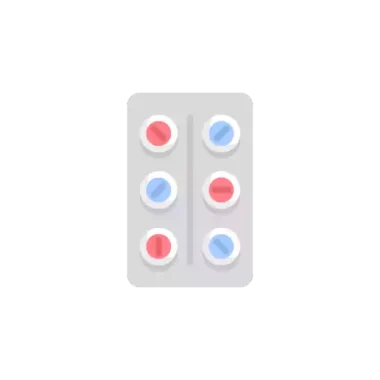Composition Itraconazole (1% w/w)
Rx Prescription Required
Pack bottle of 75 gm Powder
Storage Store below 30°C
Chemical Class Azoles {Triazoles}
Action Class Fungal Ergosterol Synthesis Inhibitor
Habbit Forming
Manufacturer Blaze Remedies
Manufacturer address WP-475,Shiv Market,New Delhi-110052

Anitra 1% Powder
Anitra 1% Powder is an antifungal medicine that helps treat infections of the skin, fingernails, and toenails. It kills the fungi by destroying the fungal cell membrane. This way it stops the growth of fungus and heals the infections.
Basic Info
Description
Anitra 1% Powder is an antifungal medicine that helps treat infections of the skin, fingernails, and toenails. It kills the fungi by destroying the fungal cell membrane. This way it stops the growth of fungus and heals the infections.
Anitra 1% Powder is for external use only. Use it in the dose and duration as advised by your doctor. Clean and dry the affected area before applying the medicine. Wash your hands thoroughly before and after the application. Do not use the medicine for longer than your doctor has told you to and let them know if your condition does not improve after 2 to 4 weeks of treatment. If you have athlete’s foot, wash your socks or tights thoroughly and change your shoes daily if possible.
Some of the common side effects of this medicine include skin irritation, redness, or itching at the site of application. Please consult your doctor if the side effects persist for a longer duration. Avoid direct contact with your eyes. In case of direct contact, wash your eyes with water and seek immediate medical attention.
It is not likely that other medicines you take by mouth or injection will affect the way this medicine works, but talk to your doctor before using it if you have recently used another medicine that contains a steroid or had an allergic reaction to another antifungal medicine. Pregnant or breastfeeding should consult their doctor to make sure it is safe for them and the baby.
Uses
Treatment of Fungal infections
Treatment of Fungal skin infections
How To Use
Use this medicine in the dose and duration as advised by your doctor. Check the label for directions before use.
MOA
Anitra 1% Powder is an antifungal medication which treats skin infections. It works by killing the fungi on the skin by destroying their cell membrane.
What If
Q: What if you forget to take Anitra Powder?
A: If you miss a dose of Anitra 1% Powder, apply it as soon as possible. However, if it is almost time for your next dose, skip the missed dose and go back to your regular schedule. Do not double the dose.
Drug Tips
Anitra 1% Powder helps treat skin infections caused by many different types of fungi.
Finish the full course of treatment even if you feel better.
It can take a few weeks for the infection to clear and a few months before the skin returns to its normal color.
Apply an amount sufficient to cover the affected area and 1 inch of the immediate surrounding skin.
Avoid getting in the eyes, nose, or mouth. If accidental exposure occurs, rinse immediately with plenty of water.
Inform your doctor if the infection has not cleared up after four weeks of treatment.
Faqs
Q. What is Anitra 1% Powder used for?
Anitra 1% Powder is used to treat fungal infections caused by Trichophyton spp., Microsporum spp., and Epidermophyton floccosum. The infections caused could be ringworm infection, infection of feet, or infection in groin and buttocks. This medicine also treats persistent infection of fingernails and toenails, persistent candida (yeast) infections of vagina or candida (yeast) infections of the mouth or throat in patients with lower resistance to disease. It is also used in the treatment of cryptococcal infection and infections caused by histoplasma, aspergillus and blastomyces.
Q. Anitra 1% Powder is effective against which fungi?
Anitra 1% Powder is effective against Trichophyton species which cause ringworm infection, athlete’s foot, and jock itch (fungal infection of the skin in the groin or buttocks). It is also effective against yeast known as Candida which commonly causes vaginal thrush (infection caused by an overgrowth of yeast called Candida albicans).
Q. How to use Anitra 1% Powder?
Before using Anitra 1% Powder, clean and dry the affected area. Gently and thoroughly massage it into the skin. Be careful not to get the medication in your eyes or mouth. If Anitra 1% Powder gets in your eyes accidentally, wash with plenty of water and call your doctor if your eyes are irritated.
Q. For how long do I need to take Anitra 1% Powder?
The dose and length of treatment will depend on the type and site of infection and your response to the treatment. For example, if you are taking Anitra 1% Powder for athlete’s foot (fungal infection of the skin on the feet and between the toes), the dose may need to be taken for 30 days. While, on the other hand, if you are taking it for candidal infection of vagina, the dose may take about 1 to 3 3 days depending on the dosage advised by the doctor.
Q. I am taking Anitra 1% Powder for nail infection but there does not seem to be any improvement. Can I stop taking it?
No, you should not stop taking Anitra 1% Powder without completing the entire course. This is because if you stop the medication then your fungal infection may not get completely cured. It usually takes about 6-9 months for the nail lesions to get cured and after that the new nail also takes several months to grow. Therefore, do not worry if you do not see any improvement during the treatment.
Q. What precautions do I need to take while using Anitra 1% Powder?
Be careful not to get Anitra 1% Powder into your eyes or mouth. If you happen to get it in your eyes, rinse off with plenty of water immediately and contact your doctor. You must not use Anitra 1% Powder if you are allergic to it or any of its ingredients. Let your doctor know if you notice any allergic reaction while using it for the first time. Inform your doctor if you are taking any medicines regularly to prevent any allergic reaction with other medicines. Do not cover the area being treated with Anitra 1% Powder with a bandage, as this may increase absorption of this medicine and increase the side effects. Do not use more than what is recommended to relieve your symptoms faster. Using more than what is advised will only increase the side effects. Also, it is advised to inform your doctor if you are planning to conceive. Pregnant and breastfeeding mothers should use Anitra 1% Powder only if prescribed by the doctor.
Q. For how long should I apply Anitra 1% Powder? Can I stop if the symptoms have completely disappeared?
The duration of treatment with Anitra 1% Powder depends on the type of infection. In general, the treatment for tinea infection is advised for 1 month and candida infection for at least 15 days. Do not stop the treatment on your own even if you feel better because the infection may come back as it takes some time to kill the fungus.
Q. Is Anitra 1% Powder safe to use in children?
Anitra 1% Powder is safe for children only if taken as directed by the doctor. It should be given to children in the correct dose only for the prescribed length of time. Minor side effects may occur but usually, they are not bothersome. However, if you develop a burning sensation, redness, and itching (which is severe in nature), stop the medicine and contact your doctor.
Q. Are there any measures that should be taken to help a faster recovery?
Keep the affected skin areas clean and dry but avoid excessive rubbing. You may have the urge to scratch because of itchiness but avoid scratching as it will damage the surface of the skin and cause the infection to spread further. Do not share towels, bath mats, etc. with other people as you could spread the infection to them.
Q. Does Anitra 1% Powder affect contraception?
Anitra 1% Powder may reduce the effectiveness of rubber contraceptives, like diaphragms and condoms. If you are using the cream on the vulva or penis, it is advised to use alternative methods of contraception for at least 5 days after using Anitra 1% Powder.
Q. By when can I expect to start seeing the improvements?
The symptoms of skin infection, such as itching or soreness, should improve within a few days of treatment. However, other signs such as redness and scaling may take longer to disappear. Do not stop applying this medicine before the duration advised by your doctor, even if you feel better.
Q. What should I do if I forget to use Anitra 1% Powder?
If you forget to use Anitra 1% Powder, do not worry and continue using Anitra 1% Powder as soon as you remember. However, if you are not sure and have any other doubts, please consult your doctor.
Q. What is Anitra 1% Powder used for?
Anitra 1% Powder is used to treat fungal infections caused by Trichophyton spp., Microsporum spp., and Epidermophyton floccosum. The infections caused could be ringworm infection, infection of feet, or infection in groin and buttocks. This medicine also treats persistent infection of fingernails and toenails, persistent candida (yeast) infections of vagina or candida (yeast) infections of the mouth or throat in patients with lower resistance to disease. It is also used in the treatment of cryptococcal infection and infections caused by histoplasma, aspergillus and blastomyces.
Q. For how long do I need to take Anitra 1% Powder?
The dose and length of treatment will depend on the type and site of infection and your response to the treatment. For example, if you are taking Anitra 1% Powder for athlete’s foot (fungal infection of the skin on the feet and between the toes), the dose may need to be taken for 30 days. While, on the other hand, if you are taking it for candidal infection of vagina, the dose may take about 1 to 3 3 days depending on the dosage advised by the doctor.
Q. What should I do if I skip a dose of Anitra 1% Powder?
If you forget to take your dose, take the missed dose as soon as you remember. However, if it is time for your next dose, skip the missed dose and continue with your regular schedule. Do not double the dose to make up for the forgotten dose.
Q. I am taking Anitra 1% Powder for nail infection but there does not seem to be any improvement. Can I stop taking it?
No, you should not stop taking Anitra 1% Powder without completing the entire course. This is because if you stop the medication then your fungal infection may not get completely cured. It usually takes about 6-9 months for the nail lesions to get cured and after that the new nail also takes several months to grow. Therefore, do not worry if you do not see any improvement during the treatment.
Q. Why has my doctor asked me to get blood tests done?
Your doctor may have prescribed blood tests to monitor your liver’s functioning. This is because the use of Anitra 1% Powder may cause serious liver damage. Therefore, if you develop loss of appetite, nausea, vomiting, dark urine or abdominal pain while taking Anitra 1% Powder, immediately inform your doctor.
Q. Can I take an antacid and Anitra 1% Powder together?
Anitra 1% Powder can be utilized by the body if there is sufficient acid in the stomach. Medicines for stomach ulcers, heartburn or indigestion neutralize the acid produced by the stomach. Therefore, it is advised to avoid taking antacids or any such medicine for a minimum of 2 hours after taking Anitra 1% Powder. However, if you are taking antacids (medicines that stop the production of stomach acid), take Anitra 1% Powder capsules with a drink of cola.
Q. What is drug resistance? Is it possible to develop resistance to Anitra 1% Powder?
Drug resistance is a condition when the fungi get modified in your body and the medicine is not able to work. There are reports which suggest resistance of some candida species (krusei, glabrata and tropicalis) with Anitra 1% Powder. Anitra 1% Powder should not be used for infection caused due to these species. It is advised to take the complete course of Anitra 1% Powder to avoid drug resistance.
Q. I am on alprazolam for quite some time. Is it okay if I start Anitra 1% Powder now?
Yes, you can take both Alprazolam and Anitra 1% Powder together, but keep a watch on the side effects of Alprazolam such as lightheadedness or drowsiness. If you experience side effects after taking Anitra 1% Powder, talk to your doctor who will modify the dose of alprazolam.
Q. My doctor prescribed Anitra 1% Powder to me but not to my friend who had a similar fungal infection because she was on dofetilide. Why is it so?
Your doctor did not prescribe Anitra 1% Powder to your friend because Anitra 1% Powder interferes with the working of dofetilide. This interference can cause disturbed electrical activity of the heart, which can be harmful for the patient.
Benifits
In Treatment of Fungal infections
Anitra 1% Powder is an antifungal medicine. It is used to treat infections in different parts of the body caused by fungi. It works by killing and stopping the growth of fungi. This provides relief from various symptoms caused by the infection and speeds up the healing process. You should keep taking the medicine until you complete the dose even if you get better. This will prevent the infection from returning.
Side Effects
Abdominal pain
Headache
Application site reactions (burning, irritation, itching and redness)
Nausea
Safety Profile
Alcohol:
No interaction found/established
Pregnancy:CONSULT YOUR DOCTOR
Anitra 1% Powder may be unsafe to use during pregnancy. Although there are limited studies in humans, animal studies have shown harmful effects on the developing baby. Your doctor will weigh the benefits and any potential risks before prescribing it to you. Please consult your doctor.
Breast feeding:CONSULT YOUR DOCTOR
Anitra 1% Powder is probably unsafe to use during breastfeeding. Limited human data suggests that the drug may pass into the breastmilk and harm the baby.
Driving:
No interaction found/established
Kidney:
No interaction found/established
Liver:
No interaction found/established
Refferences
Bennett JE. Antifungal Agents. In: Brunton LL, Chabner BA, Knollmann BC, editors. Goodman & Gilman’s: The Pharmacological Basis of Therapeutics. New York, New York: McGraw-Hill Medical; 2011. pp. 1576-79.
Sheppard D, Lampiris HW. Antifungal Agents. In: Katzung BG, Masters SB, Trevor AJ, editors. Basic and Clinical Pharmacology. 11th ed. New Delhi, India: Tata McGraw Hill Education Private Limited; 2009. pp. 839-40.
Briggs GG, Freeman RK, editors. A Reference Guide to Fetal and Neonatal Risk: Drugs in Pregnancy and Lactation. 10th ed. Philadelphia, PA: Wolters Kluwer Health; 2015. pp. 749-51.






